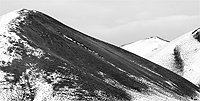As record-breaking warm temperatures continue to settle over the Northwest, winter snowpacks, which were never up to par this year to begin with, are shriveling away.
"I think it's safe to say we're not going to bust out of any drought," said Mike Huston, lead forecaster for the National Weather Service's Pocatello office.
Idaho's water gurus are starting to show some of their nerves.
"Each passing day that goes by means we are falling farther and farther behind. We've got to hope something's on the horizon, and soon," said Mike Keckler, a spokesman for the Idaho Department of Water Resources.
On the summit of Sun Valley Co.'s Bald Mountain, the natural snowpack slipped from more than 100 inches to 50 inches in the span of three weeks. After topping out around 90 percent of average following a big storm three weeks ago, the snowpack in the Big Wood River basin slipped to 77 percent of the 30-year average on Thursday, Jan. 27.
Elsewhere in Idaho, conditions are even more dismal. The Payette River basin is 63 percent of average. The Salmon River basin is 67 percent of average. The Clearwater River basin is 60 percent of its 30-year average.
All indicators are that Idaho residents are going to have to brace for another year of drought.
"It looks like the sixth year of drought is going to become a reality," Keckler said.
The story behind the unseasonably warm weather is that a large high-pressure system has been squatting over most of the Northwest for more than a week, and temperature inversions resulted. While temperatures in the valleys were close to normal, temperatures in the mountains were breaking records.
On Thursday, Jan. 20, nearly 80 record high temperatures were set at mountain snow measuring sites throughout the Northwest. The temperature that day at Vienna Mine, at 8,960 feet above sea level in the southern Sawtooth Mountains, was 48 F.
The three to four days on either side of Jan. 20 were similar, Huston said.
"The 20th happened to be the warmest," he said.
Huston said the high-pressure system would probably break down a bit this weekend, but gain strength again next week.
"This pattern is a very stagnant pattern," he said. "But that doesn't mean winter's over. We obviously have a few months left."
From Oregon to Wyoming, weather and water officials are expressing concern over the mid-winter thaw. Several large ski areas closed until more favorable conditions return.
A Washington State climatologist told the Seattle Times this week he doesn't remember ever seeing snow melting at 6,200 feet midseason before.
"We are in a pretty deep hole, and the chances of recovering are pretty slim," said Washington Climatologist Philip Mote. "It can be done, but it's like being 20-0 down halfway through a football game."
In Wyoming, Climatologist Jan Curtis said he is "extremely concerned" about the recent warm weather and its impact on snow and water conditions.
"I'm more concerned with the heat than the lack of moisture," Curtis said. "I don't mind that the snow stays where it is, but when it starts melting, that's not good."
The Idaho Water Supply Committee met Jan. 13 to discuss the state of the mid-winter snowpack. Even then, before the warm temperatures arrived, they gave pause.
The cumulative five-year drought effects are still impacting Idaho's reservoir storage, according to the Natural Resources Conservation Service. The Boise reservoir system is only at 38 percent of capacity. Magic, Bear Lake and Blackfoot reservoirs are at 10 percent of their capacities. Most other Southeast Idaho reservoirs are below 50 percent of their capacities.
Keckler said this is the longest stretch of persistent drought in 100 years of record keeping. Even the Dust Bowl era was intermingled with a wet year or two, he said.
"This is a long, suffering sequence we're having to deal with here, and there's been no relief, really."


 The Wood River Valley's south-facing slopes were covered with 3 feet of snow only a few short weeks ago. However, the Northwest has been dominated by a high-pressure system that is bringing with it record warm temperatures. There is no end in sight to the pattern. Photo by David N. Seelig
The Wood River Valley's south-facing slopes were covered with 3 feet of snow only a few short weeks ago. However, the Northwest has been dominated by a high-pressure system that is bringing with it record warm temperatures. There is no end in sight to the pattern. Photo by David N. Seelig



































